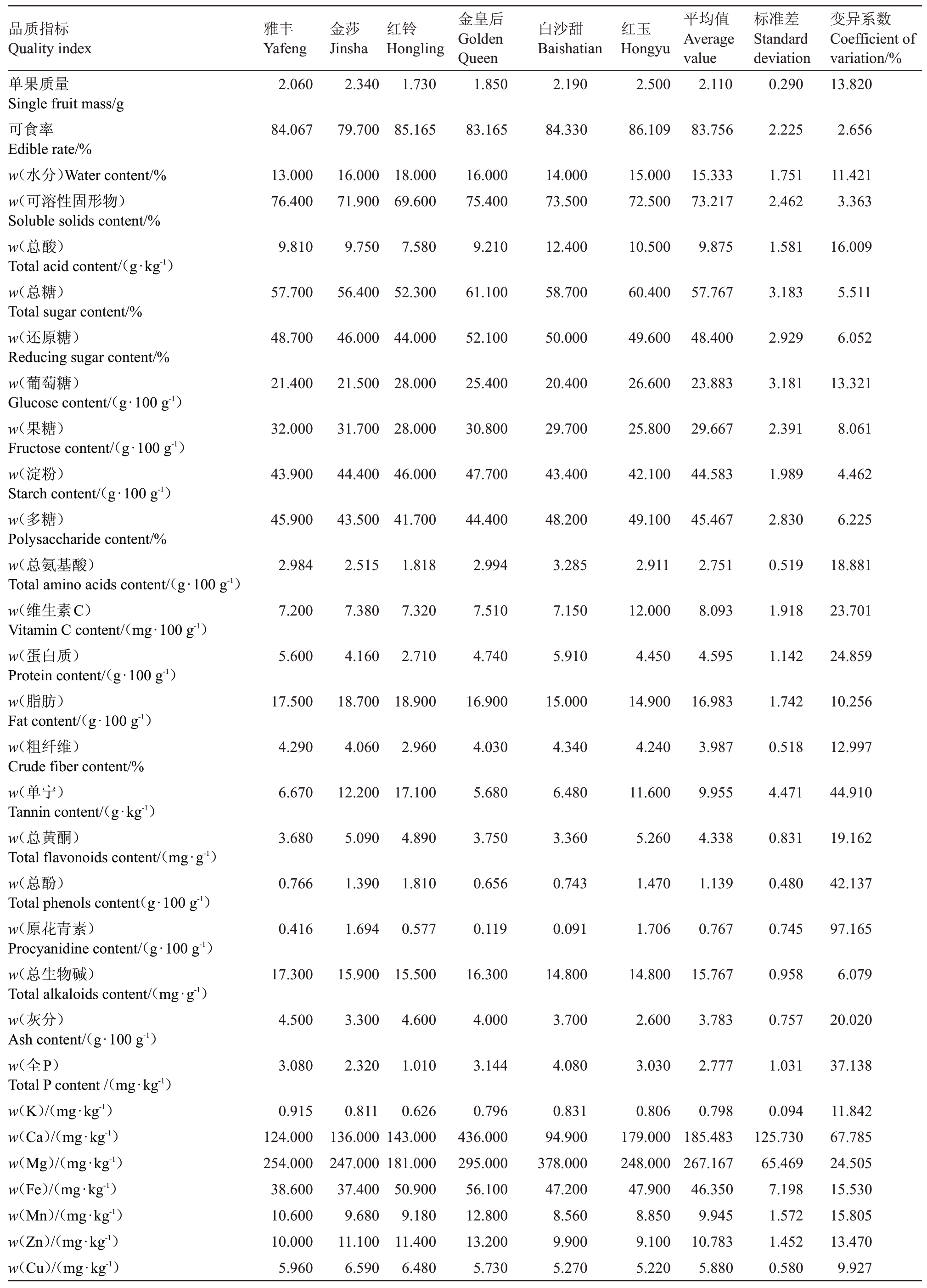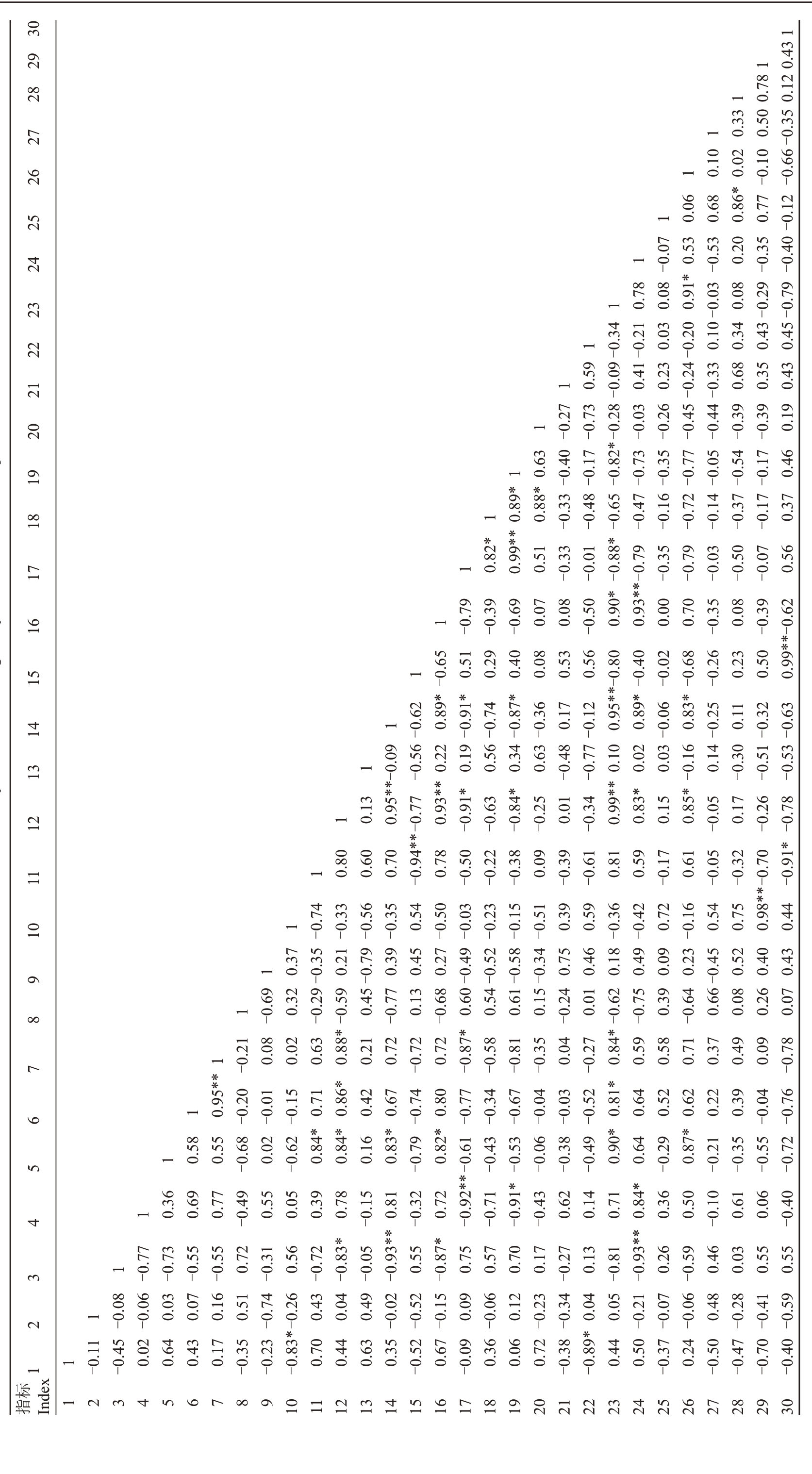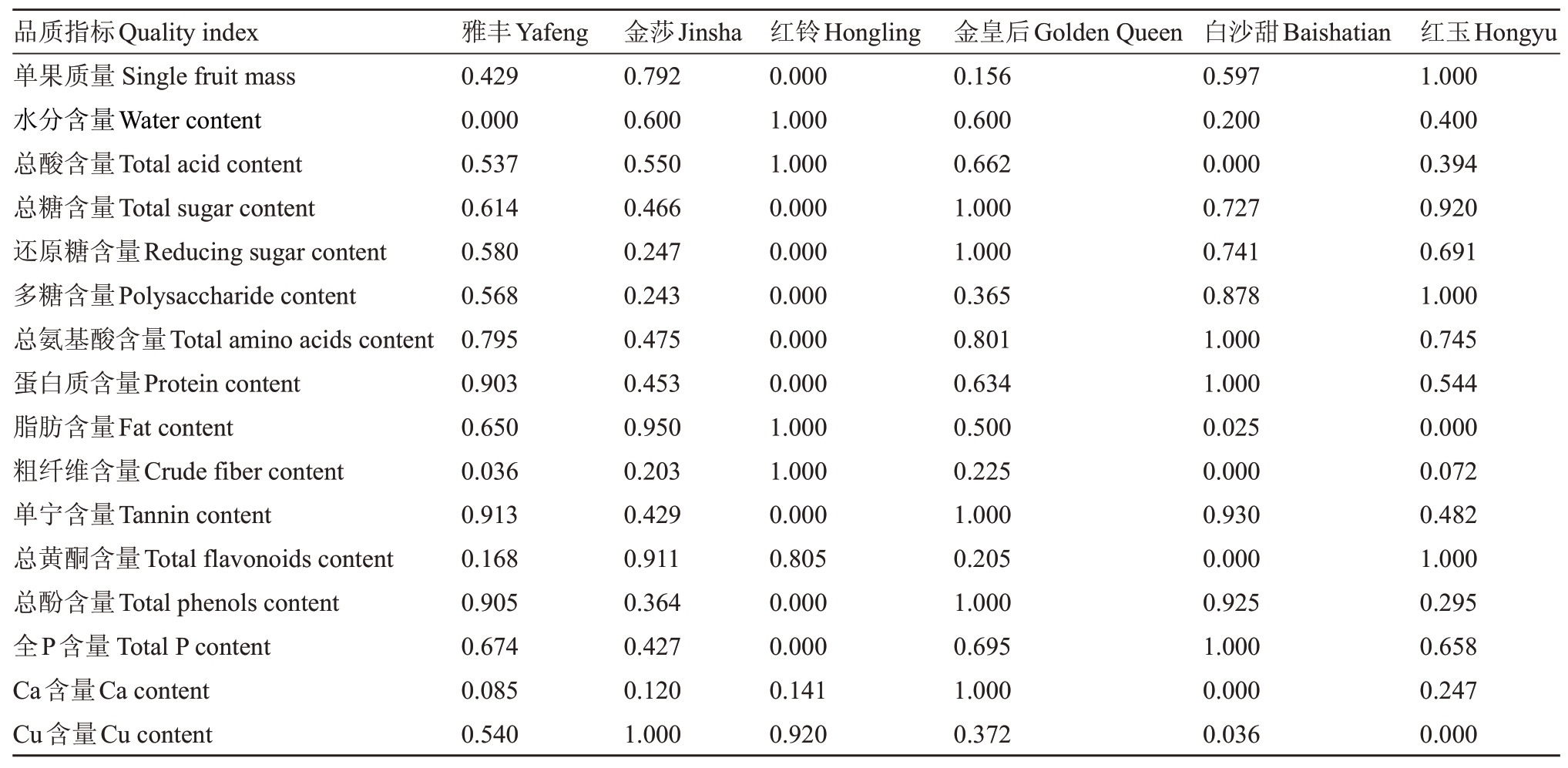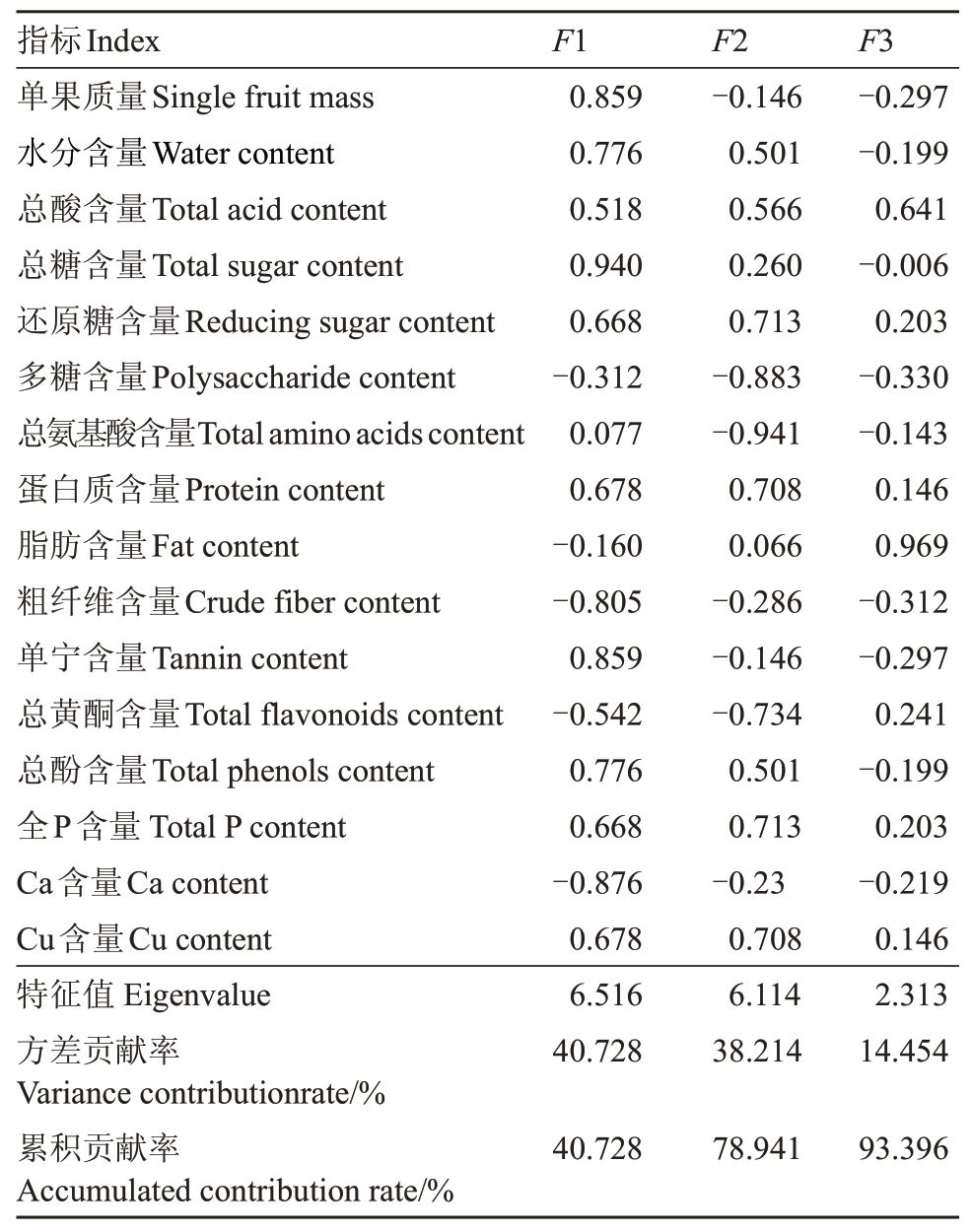大果沙枣(Elaeagnus moorcroftii),又叫大沙枣、新疆大沙枣,胡颓子科胡颓子属落叶小乔木或乔木,树高可达10 m,浓郁的芳香气味被称为“飘香沙漠的桂花”,具有生长快、抗风沙、耐贫瘠、耐盐碱等特点,是西北地区防风固沙、改良盐碱地(沙地)以及四旁绿化的主要树种[1-2]。沙枣枝、叶、花和果都具有较高的经济、生态、药用和观赏价值,开发利用前景广阔[3],目前主要用于食品、药品、化妆品、造纸、饲草等方面。
果实品质是影响果实价值的关键因素,而果实品质性状的评价是筛选林果优良品种的重要依据。前人对沙枣单果质量、果形指数及糖酸、黄酮、总糖含量等果实品质方面已有较多报道[4-5],但有关大果沙枣果实品质性状评价报道较少,主要集中在组培育苗[6]、抗逆性[7-10]、栽培[11]、营养价值[12]、药用价值[13]及果实品质(氨基酸、多糖、多酚)[14]等方面,不利于大果沙枣优良品种的推广应用[15]。因此,高产优质的新品种果实品质评价也是沙枣产业化发展中急切解决的问题。传统的感官评定[16]、方差分析[17]等方法仍不够全面,基于此,笔者在采用隶属函数法统一数量纲的基础上,结合因子分析进行果实品质的综合评价,以期为科学评价果实品质及推广优良大果沙枣品种提供理论依据。
1 材料和方法
1.1 试验材料
2022年,国家林业和草原局第一批授予大果沙枣植物新品种权6 个,包括雅丰、金莎、红铃、金皇后、白沙甜和红玉。于果实成熟期果树不同方位采集1 kg 果实,单株果实为一个试验,3 次重复,当天完成果实外观等相关指标的测定后于-80 ℃超低温保存备用。
1.2 测定项目及方法
用电子台秤测定单果质量[18];参照GB 5009.3—2016 测定水分含量[19];参照NY/T 2637—2014 测定可溶性固形物含量[20];参照GB/T 12456—2021测定总酸含量[21];参照惠秋沙[19]、武平等[22]的方法测定总糖含量;参照NY/T 2742—2015 测定还原糖含量[23];参照GB 5009.8—2023 测定果糖和葡萄糖含量[24];参照食品中淀粉的测定GB 5009.9—2016 第一法酶水解法测定淀粉含量[25];参照QB/T 5176—2017测定多糖含量[26];参照GB/T 5009 124—2016测定氨基酸含量[27];参照GB 5009.86—2016 测定维生素C含量[28];参照GB 5009.5—2016测定蛋白质含量[29];参照GB 5009.6—2016 测定脂肪含量[30];参照GB/T 5009.10—2003 测定粗纤维含量[31];参照NY/T 1600—2008测定单宁含量[32];参照王振江等[33]、韩志萍[34]的方法测定黄酮含量;参照王振江等[33]、闫祝炜等[35]的方法测定总酚含量;参照DB12/T 885—2019 测定原花青素含量[36];参照蒲俊松[37]的方法测定总生物碱含量;参照GB/T 5009.4—2016 测定灰分含量[38];参照GB 5009.87—2016 测定全磷含量[39];参照GB 5009.91—2017[40]、GB 5009.241—2017[41]、GB 5009.13—2017[42]、GB 5009.14—2017[43]、GB 5009.242—2017[44]、GB 5009.268—2016[45]分别测定矿物质元素钾、镁、铜、锌、锰、铁和钙的含量。
1.3 数据处理
使用Excel2013 软件对数据进行整理,使用SPSS19.0软件进行相关性分析[46]和因子分析[47]。对因子分析的原始数据采用隶属函数法进行标准化处理,将数据规范至[0,1]。
2 结果与分析
2.1 果实品质分析
雅丰、金莎、红铃、金皇后、白沙甜、红玉6 个品种的30项果实品质指标见表1。从各指标变异程度来看,6 个品种果实品质性状变异系数为2.656%~97.165% ,变异系数最大的是原花青素含量(97.165%),其次为钙含量(67.785%),说明原花青素和钙含量在各品种间差异较大;可溶性固形物、总糖、还原糖、果糖、淀粉、多糖、总生物碱和铜含量变异程度较小,小于10%,说明其离散程度较低,各品种间取值分布较为一致,其中,可食率变异系数仅为2.656%。
表1 大果沙枣果实品质测定结果
Table 1 The fruit quality determination results of E.moorcroftii

品质指标Quality index单果质量Single fruit mass/g可食率Edible rate/%w(水分)Water content/%w(可溶性固形物)Soluble solids content/%w(总酸)Total acid content/(g·kg-1)w(总糖)Total sugar content/%w(还原糖)Reducing sugar content/%w(葡萄糖)Glucose content/(g·100 g-1)w(果糖)Fructose content/(g·100 g-1)w(淀粉)Starch content/(g·100 g-1)w(多糖)Polysaccharide content/%w(总氨基酸)Total amino acids content/(g·100 g-1)w(维生素C)Vitamin C content/(mg·100 g-1)w(蛋白质)Protein content/(g·100 g-1)w(脂肪)Fat content/(g·100 g-1)w(粗纤维)Crude fiber content/%w(单宁)Tannin content/(g·kg-1)w(总黄酮)Total flavonoids content/(mg·g-1)w(总酚)Total phenols content(g·100 g-1)w(原花青素)Procyanidine content/(g·100 g-1)w(总生物碱)Total alkaloids content/(mg·g-1)w(灰分)Ash content/(g·100 g-1)w(全P)Total P content/(mg·kg-1)w(K)/(mg·kg-1)w(Ca)/(mg·kg-1)w(Mg)/(mg·kg-1)w(Fe)/(mg·kg-1)w(Mn)/(mg·kg-1)w(Zn)/(mg·kg-1)w(Cu)/(mg·kg-1)雅丰Yafeng 2.060金莎Jinsha 2.340红铃Hongling 1.730金皇后Golden Queen 1.850白沙甜Baishatian 2.190红玉Hongyu 2.500平均值Average value 2.110标准差Standard deviation 0.290变异系数Coefficient of variation/%13.820 84.067 79.700 85.165 83.165 84.330 86.109 83.756 2.225 2.656 13.000 76.400 16.000 71.900 18.000 69.600 16.000 75.400 14.000 73.500 15.000 72.500 15.333 73.217 1.751 2.462 11.421 3.363 9.810 9.750 7.580 9.210 12.400 10.500 9.875 1.581 16.009 57.700 56.400 52.300 61.100 58.700 60.400 57.767 3.183 5.511 48.700 46.000 44.000 52.100 50.000 49.600 48.400 2.929 6.052 21.400 21.500 28.000 25.400 20.400 26.600 23.883 3.181 13.321 32.000 31.700 28.000 30.800 29.700 25.800 29.667 2.391 8.061 43.900 44.400 46.000 47.700 43.400 42.100 44.583 1.989 4.462 45.900 43.500 41.700 44.400 48.200 49.100 45.467 2.830 6.225 2.984 2.515 1.818 2.994 3.285 2.911 2.751 0.519 18.881 7.200 7.380 7.320 7.510 7.150 12.000 8.093 1.918 23.701 5.600 4.160 2.710 4.740 5.910 4.450 4.595 1.142 24.859 17.500 18.700 18.900 16.900 15.000 14.900 16.983 1.742 10.256 4.290 4.060 2.960 4.030 4.340 4.240 3.987 0.518 12.997 6.670 12.200 17.100 5.680 6.480 11.600 9.955 4.471 44.910 3.680 5.090 4.890 3.750 3.360 5.260 4.338 0.831 19.162 0.766 1.390 1.810 0.656 0.743 1.470 1.139 0.480 42.137 0.416 1.694 0.577 0.119 0.091 1.706 0.767 0.745 97.165 17.300 15.900 15.500 16.300 14.800 14.800 15.767 0.958 6.079 4.500 3.300 4.600 4.000 3.700 2.600 3.783 0.757 20.020 3.080 2.320 1.010 3.144 4.080 3.030 2.777 1.031 37.138 0.915 124.000 254.000 38.600 10.600 10.000 5.960 0.811 136.000 247.000 37.400 9.680 11.100 6.590 0.626 143.000 181.000 50.900 9.180 11.400 6.480 0.796 436.000 295.000 56.100 12.800 13.200 5.730 0.831 94.900 378.000 47.200 8.560 9.900 5.270 0.806 179.000 248.000 47.900 8.850 9.100 5.220 0.798 185.483 267.167 46.350 9.945 10.783 5.880 0.094 125.730 65.469 7.198 1.572 1.452 0.580 11.842 67.785 24.505 15.530 15.805 13.470 9.927
2.2 不同果实品质指标的相关性分析
对大果沙枣30 项不同果实品质性状指标进行相关性分析,从表2可知,30项果实品质指标间表现出不同程度的正相关性和负相关性。其中,还原糖含量与总糖含量呈极显著正相关;淀粉含量与单果质量呈显著负相关;多糖含量与总酸含量呈显著正相关;总氨基酸含量与水分含量呈显著负相关,与总酸、总糖和还原糖含量呈显著正相关;蛋白质含量与总酸含量呈显著正相关,与总氨基酸含量呈极显著正相关,与水分含量呈极显著负相关;脂肪含量与多糖含量呈极显著负相关;粗纤维含量与总酸和蛋白质含量呈显著正相关,与总氨基酸含量呈极显著正相关,与水分含量呈显著负相关;单宁含量与还原糖、总氨基酸和蛋白质含量呈显著负相关,与可溶性固形物含量呈极显著负相关;总黄酮含量与单宁含量呈显著正相关;总酚含量与可溶性固形物、总氨基酸和蛋白质含量呈显著负相关,与总黄酮含量呈显著正相关,与单宁含量呈极显著正相关;原花青素含量与总黄酮含量呈显著正相关;灰分含量与单果质量呈显著负相关;全P 含量与总酸、总糖、还原糖和粗纤维含量呈显著正相关,与总氨基酸和蛋白质含量呈极显著正相关,与单宁和总酚含量呈显著负相关;钾含量与可溶性固形物、总氨基酸和蛋白质含量呈显著正相关,与粗纤维含量呈极显著正相关,与水分含量呈极显著负相关;镁含量与总酸、总氨基酸、蛋白质和全P含量呈显著正相关;锰含量与钙含量呈显著正相关;锌含量与淀粉含量呈极显著正相关;铜含量与脂肪含量呈极显著正相关,与多糖含量呈显著负相关。以上分析结果表明,沙枣品种的各项品质指标间存在一定的相关性,并非完全独立,且有些指标高度相关。因此,可以对这些高度相关的指标进行筛选,从而简化果实品质评价指标体系。此外,表中显示单果质量与淀粉和灰分含量呈显著负相关;水分含量与总氨基酸和粗纤维含量呈显著负相关,与蛋白质和总K含量呈极显著负相关,这表明外部感官品质与内在品质间也存在着一定的关联性。
表2 大果沙枣不同品质指标的相关性分析
Table 2 Correlation analysis of different quality traits of E. moorcroftii

注:1-30 分别代表单果质量、可食率及水分、可溶性固形物、总酸、总糖、还原糖、葡萄糖、果糖、淀粉、多糖、总氨基酸、维生素C、蛋白质、脂肪、粗纤维、单宁、总黄酮、总酚、原花青素、总生物碱、灰分、全P、K、Ca、Mg、Fe、Mn、Zn 和Cu 含量。*表示在0.05 水平显著相关;**表示在0.01 水平极显著相关。
Note: 1-30 represents single fruit weight, edible rate, water rate, soluble solid, total acid, total sugar, reducing sugar, glucose, fructose, starch, polysaccharide, total amino acids, Vitamin C, protein, fat, crude fiber,tannin, total flavonoids, total phenols,procyanidine,total alkaloids, ash, total P, K, Ca, Mg, Fe, Mn, Zn and Cu content, respectively. * represents significant correlation at 0.05 level; ** represents extremely significantly correlation at 0.01 level.
301 2910.43 2810.78 2710.33 0.50 0.12 2610.10 0.02-0.10-0.35-0.66 2510.06 0.68 0.86*0.77 241-0.07 0.53-0.53 0.20-0.35-0.12-0.40 2310.78 0.08 0.91*0.08 221-0.34 0.03-0.03 0.10 0.34-0.29 0.43-0.79 0.45 2110.59-0.21-0.09 0.41 0.23-0.20 0.68 0.35 0.43-0.73 201-0.27-0.28-0.03-0.26-0.24-0.45-0.33-0.44-0.39-0.39 0.19-0.40 1910.63-0.82*1810.89*-0.33-0.48-0.73-0.65-0.35-0.47-0.77-0.16-0.17-0.05-0.72-0.54 0.88*-0.17-0.14 0.46-0.37-0.17 0.37 0.51 1710.82*-0.33 0.99**-0.01-0.88*-0.79-0.35-0.79-0.03-0.50-0.07 0.56 161-0.79-0.39-0.69 0.07 0.08-0.50 0.90*0.93**0.00 0.70-0.35 0.08-0.39-0.62 151-0.65 0.51 0.29 0.40 0.08 0.53 0.56-0.80-0.40-0.02-0.68-0.26 0.23 0.50 0.99**141-0.62 0.89*-0.91*-0.74-0.87*-0.36 0.17-0.12 0.95**0.89*-0.06 0.83*-0.25 0.11-0.32-0.63 131-0.09-0.56 0.22 0.19 0.56 0.34 0.63-0.48-0.77 0.10 0.02 0.03-0.16 0.14-0.30-0.51-0.53 1210.13 0.95**-0.77 0.93**-0.91*-0.63-0.84*-0.25 0.01-0.34 0.99**0.83*0.15 0.85*-0.05 0.17-0.26-0.78 1110.80 0.60 0.70-0.94**0.78-0.50-0.22-0.38 0.09-0.39-0.61 0.81 0.59-0.17 0.61-0.05-0.32-0.70-0.91*101-0.74-0.33-0.56-0.35 0.54-0.50-0.03-0.23-0.15-0.51 0.39 0.59-0.36-0.42 0.72-0.16 0.54 0.75 0.98**0.44 10.37-0.35 0.21-0.79 0.39 0.45 0.27-0.49-0.52-0.58-0.34 0.75 0.46 0.18 0.49 0.09 0.23-0.45 0.52 0.40 0.43 9 8 1-0.69 0.32-0.29-0.59 0.45-0.77 0.13-0.68 0.60 0.54 0.61 0.15-0.24 0.01-0.62-0.75 0.39-0.64 0.66 0.08 0.26 0.07 1-0.21 0.08 0.02 0.63 0.88*0.21 0.72-0.72 0.72-0.87*-0.58-0.81-0.35 0.04-0.27 0.84*0.59 0.58 0.71 0.37 0.49 0.09-0.78 7 6 10.95**-0.20-0.01-0.15 0.71 0.86*0.42 0.67-0.74 0.80-0.77-0.34-0.67-0.04-0.03-0.52 0.81*0.64 0.52 0.62 0.22 0.39-0.04-0.76 0.55 10.58-0.68 0.02-0.62 0.84*0.84*0.16 0.83*-0.79 0.82*-0.61-0.43-0.53-0.06-0.38-0.49 0.90*0.64-0.29 0.87*-0.21-0.35-0.55-0.72 5 10.36 0.69 0.77-0.49 0.55 0.05 0.39 0.78-0.15 0.81-0.32 0.72-0.92**-0.71-0.91*-0.43 0.62 0.14 0.71 0.84*0.36 0.50-0.10 0.61 0.06-0.40 4 1-0.77-0.73-0.55-0.55 0.72-0.31 0.56-0.72-0.83*-0.05-0.93**0.55-0.87*0.75 0.57 0.70 0.17-0.27 0.13-0.81-0.93**0.26-0.59 0.46 0.03 0.55 0.55 3 21-0.08-0.06 0.03 0.07 0.16 0.51-0.74-0.26 0.43 0.04 0.49-0.02-0.52-0.15 0.09-0.06 0.12-0.23-0.34 0.04 0.05-0.21-0.07-0.06 0.48-0.28-0.41-0.59 11-0.11 0.02 0.64 0.43 0.17 0.70 0.44 0.63 0.35 0.67 0.36 0.06 0.72 0.44 0.50 0.24指Index -0.45-0.35-0.23-0.83*-0.52-0.09-0.38-0.89*-0.37-0.50-0.47-0.70-0.40标123456789101112131415161718192021222324252627282930
2.3 果实品质的因子分析
依据以上分析结果,剔除变异程度小于5%和相关性较低的14项果实品质指标:可食率及可溶性固形物、淀粉、果糖、葡萄糖、维生素C、原花青素、总生物碱、灰分、钾、镁、铁、锰和锌含量,对其余16项果实品质指标采用隶属函数法进行数据标准化,见表3。
表3 16 项果实品质指标标准化结果
Table 3 Data normalization of 16 quality indicators of E.moorcroftii

品质指标Quality index单果质量Single fruit mass水分含量Water content总酸含量Total acid content总糖含量Total sugar content还原糖含量Reducing sugar content多糖含量Polysaccharide content总氨基酸含量Total amino acids content蛋白质含量Protein content脂肪含量Fat content粗纤维含量Crude fiber content单宁含量Tannin content总黄酮含量Total flavonoids content总酚含量Total phenols content全P含量Total P content Ca含量Ca content Cu含量Cu content雅丰Yafeng 0.429 0.000 0.537 0.614 0.580 0.568 0.795 0.903 0.650 0.036 0.913 0.168 0.905 0.674 0.085 0.540金莎Jinsha 0.792 0.600 0.550 0.466 0.247 0.243 0.475 0.453 0.950 0.203 0.429 0.911 0.364 0.427 0.120 1.000红铃Hongling 0.000 1.000 1.000 0.000 0.000 0.000 0.000 0.000 1.000 1.000 0.000 0.805 0.000 0.000 0.141 0.920金皇后Golden Queen 0.156 0.600 0.662 1.000 1.000 0.365 0.801 0.634 0.500 0.225 1.000 0.205 1.000 0.695 1.000 0.372白沙甜Baishatian 0.597 0.200 0.000 0.727 0.741 0.878 1.000 1.000 0.025 0.000 0.930 0.000 0.925 1.000 0.000 0.036红玉Hongyu 1.000 0.400 0.394 0.920 0.691 1.000 0.745 0.544 0.000 0.072 0.482 1.000 0.295 0.658 0.247 0.000
为了将大量冗杂的原始信息简化为少数综合变量,采用主成分分析——利用少数综合指标来评价原始信息的综合评价方法[20]对本文数据进行分析评价。以特征值>1.0 为标准提取主成分,3 个主成分的特征值>1.0。表4 统计了3 个主成分的载荷值、特征值和贡献率,其累积贡献率达93.396%,代表了6 种大果沙枣的16 项果实品质指标,可以作为综合评价大果沙枣果实品质的指标。
表4 旋转后的因子载荷矩阵和方差贡献率
Table 4 Rotated factor loading matrix and variance contribution rate

指标Index单果质量Single fruit mass水分含量Water content总酸含量Total acid content总糖含量Total sugar content还原糖含量Reducing sugar content多糖含量Polysaccharide content总氨基酸含量Totalaminoacidscontent蛋白质含量Protein content脂肪含量Fat content粗纤维含量Crude fiber content单宁含量Tannin content总黄酮含量Total flavonoids content总酚含量Total phenols content全P含量Total P content Ca含量Ca content Cu含量Cu content特征值Eigenvalue方差贡献率Variance contributionrate/%累积贡献率Accumulated contribution rate/%F1 0.859 0.776 0.518 0.940 0.668-0.312 0.077 0.678-0.160-0.805 0.859-0.542 0.776 0.668-0.876 0.678 6.516 40.728 F2-0.146 0.501 0.566 0.260 0.713-0.883-0.941 0.708 0.066-0.286-0.146-0.734 0.501 0.713-0.23 0.708 6.114 38.214 F3-0.297-0.199 0.641-0.006 0.203-0.330-0.143 0.146 0.969-0.312-0.297 0.241-0.199 0.203-0.219 0.146 2.313 14.454 40.728 78.941 93.396
主成分载荷矩阵经5次迭代后的旋转因子载荷值见表4。由此可知,第1 主成分的贡献率为40.728%,主要代表单果质量及水分、总糖、粗纤维素、单宁、总酚含量6 项指标的信息。第2 主成分的贡献率为38.214%,主要代表还原糖、多糖、总氨基酸、蛋白质、总黄酮、全P 和Cu 含量。第3 主成分的贡献率为14.454%,主要代表总酸和脂肪含量。
2.4 各主成分综合得分
将各项指标的载荷值除以相应主成分的特征值即可得到得分矩阵(略),再将得分矩阵中的载荷值开算术平方根即可作为每个指标的载荷系数,将得分矩阵同经标准化转化的数据相乘,即可得到各主成分的算术表达式:
F1=0.337Zx1-0.212Zx2+0.304Zx3+0.266Zx4+0.203Zx5+0.368Zx6+0.262Zx7-0.201Zx8-0.343Zx9+0.285Zx10- 0.122Zx11 + 0.030Zx12- 0.062Zx13 +0.266Zx14-0.063Zx15-0.315Zx16;
F2=0.347Zx1-0.219Zx2+0.314Zx3+0.275Zx4+0.209Zx5+0.380Zx6+0.270Zx7+0.207Zx8-0.354Zx9+0.294Zx10- 0.126Zx11 + 0.031Zx12- 0.064Zx13 +0.274Zx14-0.065Zx15-0.326Zx16;
F3=-0.096Zx1-0.483Zx2+0.329Zx3+0.256Zx4+0.372Zx5+0.171Zx6+0.469Zx7+0.563Zx8-0.151Zx9+0.386Zx10- 0.581Zx11- 0.619Zx12- 0.641Zx13 +0.466Zx14+0.043Zx15-0.188Zx16。
用特征值除以所有主成分特征值之和,可以计算出综合评价函数F=0.436F1+0.409F2+0.155F3。
综合来看,大果沙枣的综合评价得分范围为-0.297~1.407。果实品质指标排名位列前3 的品种分别为红玉、白沙甜和雅丰,综合得分分别为1.407、1.299、0.766。其中红玉果实在F1和F2排名均居第1,而在F3 上排名第3;白沙甜果实在F1 和F2 上排名均居第2,F3排在第1,综合得分排序为第2;雅丰果实的F1、F2 排在第3,F3 排在第2,综合得分排序为第3(表5)。
表5 大果沙枣果实品质指标各公因子得分和累积得分
Table 5 Comparison and ranking of scores of common factors and overall scores of E.moorcroftii

品种Variety雅丰Yafeng金莎Jinsha红铃Hongling金皇后Golden Queen白沙甜Baishatian红玉Hongyu F1 0.815排序Rank F2 0.841排序Rank F3 0.429排序Rank F 排序Rank 0.260 0.269 356421-0.539 0.140 256413-0.583 0.766-0.241-0.249-0.297 0.786 0.811 0.324 0.725 1.363 1.407 0.837 1.299 1.562 35642 1 1.613 0.426 1.407 356421
3 讨论
果实品质是决定大果沙枣品种选育和市场竞争力的关键,笔者在本研究中对6个品种30项果实品质指标进行了测定,各指标变异系数在2.656%~97.165%。变异系数最大的是原花青素含量(97.165%),变异系数最小的为可食率(2.656%)。徐金等[48]研究表明,48个沙枣品种的品质指标中,维生素C 含量变异系数最大,为35.1%。笔者在本研究中发现大果沙枣维生素C 含量的变异系数为23.701%,较前人的研究偏低,可能与沙枣品种材料较少有关,在今后果实品质评价中可增大群体数量。
因果实品质指标单位的不一致,在进行因子分析前需进行指标标准化处理[49],笔者在本研究中采用隶属函数法和因子分析对6个大果沙枣品种(系)16项果实品质指标进行综合评价。结果表明,排名前3 位的分别是红玉、白沙甜和雅丰。常用的果实评价方法,主要采用感官评价[50]、方差分析[51]等,受主观性、多因素性等要素制约,评价结果具有片面性及不确定性。近些年,在选择果实品质评价方法上,越来越倾向于主成分分析[52-53],主成分分析是将多个指标通过线性变换选出较少的综合因子来代表众多的因子[54],已被广泛应用于多种园艺作物品质的综合评价[51],目前此法已在酿酒葡萄[55]、枸杞[56]、梨[57]等资源评价上得以广泛运用。笔者在本研究中剔除变异程度小于5%和相关性较低的果实品质指标,通过因子分析、主成分分析将原有的多个指标,简化为代表不同果品性状表现的3个主成分,包括16个大果沙枣果实品质指标,累积方差贡献率达93.396%,由此可见,3 个主成分更有利于全面把握各个品种的综合指标性状,排名得分结果更为客观合理。不同分析方法,对果树果实品质计算方法和评价侧重点各有所不同,在今后的大果沙枣品种果实评价工作中,可采用聚类分析法、主成分分析等多种方法相互结合和验证进行果实品质的综合评价,进而获得更加准确的结论。除此之外,品种的抗逆性、耐贮性、丰产性等方面的因素对大果沙枣品种的综合评价也十分重要,所以优良品种的筛选应在果实品质评价的基础上,结合其他农艺性状进行科学评价,从而筛选出适宜新疆种植推广的优良品种。
4 结论
通过对6个大果沙枣新品种30项果实品质指标进行测定,采用相关性分析和因子分析进行综合评价,提取到3 个主成分,主要代表单果质量及水分、总糖、粗纤维、单宁、总酚、还原糖、多糖、总氨基酸、蛋白质、总黄酮、全P、铜、总酸、脂肪含量共16 个指标,累积贡献率可达93.396%。对大果沙枣品种果实综合品质的优劣进行综合得分排序,红玉的果实综合品质排名最高,其次为白沙甜,雅丰第3。研究结果为新疆大果沙枣优良品种的选育和推广应用提供了参考依据。
[1] 齐曼·尤努斯,李秀霞,李阳,高桥久光.盐胁迫对大果沙枣膜脂过氧化和保护酶活性的影响[J].干旱区研究,2005,22(4):503-507.Qiman·Yunus,LI Xiuxia,LI Yang,GAOQIAO Jiuguang. Effects of salt stress on membrane lipid peroxidation and protective enzymes in leaves of Elaeagnus angustifolia L.[J]. Arid Zone Research,2005,22(4):503-507.
[2] 李磊,贾志清,宁虎森,吉小敏,朱雅娟,綦艳林.水分胁迫下2种沙枣的抗旱性比较[J].林业科学研究,2009,22(3):335-342.LI Lei,JIA Zhiqing,NING Husen,JI Xiaomin,ZHU Yajuan,QI Yanlin. Drought resistance of two Elaeagnus species under water stress[J].Forest Research,2009,22(3):335-342.
[3] 郭林繁,毕春竹,宋振琪,王秀军,耿红凯,李子航,罗春燕,李庆卫.碱性盐胁迫对不同种源沙枣幼苗的生理影响[J].西北林学院学报,2023,38(4):51-60.GUO Linfan,BI Chunzhu,SONG Zhenqi,WANG Xiujun,GENG Hongkai,LI Zihang,LUO Chunyan,LI Qingwei.Physiological response of alkaline salt stress on Elaeagnus angustifolia seedlings from different provenances[J]. Journal of Northwest Forestry University,2023,38(4):51-60.
[4] 王芸芸.沙枣的优系初选及加工性能评价[D].泰安:山东农业大学,2020.WANG Yunyun. Primary selection of superior lines and evaluation of processing performance of Elaeagnus angustifolia[D].Tai’an:Shandong Agricultural University,2020.
[5] 王雅,赵萍,王玉丽,张轶.野生沙枣果实营养成分研究[J].甘肃农业大学学报,2006,41(6):130-132.WANG Ya,ZHAO Ping,WANG Yuli,ZHANG Yi. Nutritional composition of wild Elaeagnus angustifolia fruits[J]. Journal of Gansu Agricultural University,2006,41(6):130-132.
[6] 杨育红,张文辉.沙枣组织脱分化培养与快繁体系建立的研究[J].植物研究,2006,26(4):435-441.YANG Yuhong,ZHANG Wenhui. Induction differentiation and plant regeneration of Elaeagnus angustifolia[J]. Bulletin of Botanical Research,2006,26(4):435-441.
[7] 刘正祥,张华新,杨升,杨秀艳,狄文彬.NaCl 胁迫对沙枣幼苗生长和光合特性的影响[J].林业科学,2014,50(1):32-40.LIU Zhengxiang,ZHANG Huaxin,YANG Sheng,YANG Xiuyan,DI Wenbin.Effects of NaCl stress on growth and photosynthetic characteristics of Elaeagnus angustifolia seedlings[J].Scientia Silvae Sinicae,2014,50(1):32-40.
[8] 李思思.NaCl 和Na2SO4 盐胁迫对沙枣生长和生理生化特性的影响[D].北京:北京林业大学,2017.LI Sisi. Effects of NaCl and Na2SO4 saline stress on growth and physiological and biochemical characteristics of Elaeagnus angustifolia[D].Beijing:Beijing Forestry University,2017.
[9] 李阳,齐曼·尤努斯,祝燕.水分胁迫对大果沙枣光合特性及生物量分配的影响[J].西北植物学报,2006,26(12):2493-2499.LI Yang,Qiman·Yunus,ZHU Yan. Effects of water stress on photosynthetic characteristics and biomass partition of Elaeagnus moorcroftii[J]. Acta Botanica Boreali-Occidentalia Sinica,2006,26(12):2493-2499.
[10] 罗青红,周斌,李英仑,阿不都热西提·热合曼.盐渍土壤大果沙枣树主要矿质阳离子的吸收和分配特征[J].西北植物学报,2021,41(8):1371-1379.LUO Qinghong,ZHOU Bin,LI Yinglun,Abudurexiti·Reheman.Absorption and distribution of main mineral cations of Elaeagnus moorcroftii in salinized land[J].Acta Botanica Boreali-Occidentalia Sinica,2021,41(8):1371-1379.
[11] FOLLSTAD SHAH J J,HARNER M J,TIBBETS T M.Elaeagnus angustifolia elevates soil inorganic nitrogen pools in riparian ecosystems[J].Ecosystems,2010,13(1):46-61.
[12] 周尚臻.沙枣果肉乙酸乙酯部位化学成分及活性研究[D].兰州:兰州理工大学,2013.ZHOU Shangzhen. The research on chemical component and their activities of ethyl acetate fraction from flesh of Elaeagnus angustifolia L.[D]. Lanzhou:Lanzhou University of Technology,2013.
[13] 万超超,王东东,郭敬宇,孙芸.新疆沙枣花抗氧化活性研究及总黄酮测定[J].化学工程师,2022,36(4):15-19.WAN Chaochao,WANG Dongdong,GUO Jingyu,SUN Yun.Study on antioxidant activity of Elaeagnus angustifolia flower and determination of total flavonoids[J]. Chemical Engineer,2022,36(4):15-19.
[14] 宋海龙.大果沙枣果实性状及化学成分与质量标准的研究[D].乌鲁木齐:新疆农业大学,2015.SONG Hailong.Study on the fruit shape and chemical composition and quality standard of Elaeagnus moorcroftii fruit[D].Urumqi:Xinjiang Agricultural University,2015.
[15] 管文轲,徐娜.沙枣资源利用研究与开发现状述评[J].安徽农学通报(上半月刊),2012,18(19):119-120.GUAN Wenke,XU Na.Research situation and resources utilization of Elaeagnus angustifolia[J]. Anhui Agricultural Science Bulletin,2012,18(19):119-120.
[16] 罗青红,史彦江,宋锋惠,俞涛.不同产地杂交榛果实品质比较分析[J].食品科学,2013,34(3):50-54.LUO Qinghong,SHI Yanjiang,SONG Fenghui,YU Tao. Comparative analysis of the quality of hybrid hazels from different growing areas[J].Food Science,2013,34(3):50-54.
[17] 白沙沙,毕金峰,方芳,王沛,公丽艳.苹果品质评价技术研究现状及展望[J].食品科学,2011,32(3):286-290.BAI Shasha,BI Jinfeng,FANG Fang,WANG Pei,GONG Liyan.Current research progress and prospects of technologies for apple quality evaluation[J].Food Science,2011,32(3):286-290.
[18] 冯会丽,吴正保,史彦江,张亚鸽,谢亚丽,马合木提·阿不来提.基于因子分析的灰枣优良无性系果实品质评价[J].食品科学,2016,37(9):77-81.FENG Huili,WU Zhengbao,SHI Yanjiang,ZHANG Yage,XIE Yali,Mahemuti·Abulaiti. Fruit quality evaluation of superior clones of Zizyphus jujuba cv.Huizao based on factor analysis[J].Food Science,2016,37(9):77-81.
[19] 惠秋沙.蒽酮-硫酸法测定桑葚乌发粥中粗多糖的含量[J].农产品加工(学刊),2011(10):105-107.HUI Qiusha. Content determination of total polysaccharides in sangshen wufa gruel by anthrone-sulfuric acid method[J].Academic Periodical of Farm Products Processing,2011(10):105-107.
[20] 中华人民共和国农业部.水果和蔬菜可溶性固形物含量的测定折射仪法:NY/T 2637—2014[S].北京:中国农业出版社,2015.Ministry of Agriculture of the People’s Republic of China. Refractometric method for determination of total soluble solids in fruits and vegetables:NY/T 2637—2014[S]. Beijing:China Agriculture Press,2015.
[21] 中华人民共和国国家卫生健康委员会,国家市场监督管理总局. 食品安全国家标准食品中总酸的测定:GB 12456—2021[S].北京:中国标准出版社,2021.National Health Commission of the People’s Republic of China,State Administration for Market Regulation. National food safety standard-Determination of Total Acid in Foods:GB 12456—2021[S].Beijing:Standards Press of China,2021.
[22] 武平,赵文婧,徐晓娇,段学强.测定葡萄酒中总糖方法的探讨[J].中国酿造,2011,30(1):163-165.WU Ping,ZHAO Wenjing,XU Xiaojiao,DUAN Xueqiang.Methods for determination of total sugar content in wine[J].China Brewing,2011,30(1):163-165.
[23] 中华人民共和国农业部.水果及制品可溶性糖的测定3,5-二硝基水杨酸比色法:NY/T 2742—2015[S]. 北京:中国农业出版社,2015.Ministry of Agriculture of the People’s Republic of China. Determination of soluble sugar in fruits and derived products-3,5-dinitrosalicylic acid colorimetry:NY/T 2742—2015[S].Beijing:China Agriculture Press,2015.
[24] 中华人民共和国国家卫生健康委员会,国家市场监督管理总局.食品安全国家标准食品中果糖、葡萄糖、蔗糖、麦芽糖、乳糖的测定:GB 5009.8—2023[S].北京:中国标准出版社,2023.National Health Commission of the People’s Republic of China,State Administration for Market Regulation. National food safety standards-Determination of fructose, glucose, sucrose, maltose and lactose in foods:GB 5009.8—2023[S]. Beijing:Standards Press of China,2023.
[25] 中华人民共和国国家卫生和计划生育委员会,国家食品药品监督管理总局. 食品安全国家标准食品中淀粉的测定:GB 5009.9—2016[S].北京:中国标准出版社,2017.National Health and Family Planning Commission of the People’s Republic of China,China Food and Drug Administration.National food safety standard-Determination of starch in foods:GB 5009.9—2016[S].Beijing:Standards Press of China,2017.
[26] 中华人民共和国工业和信息化部. 枸杞多糖:QB/T 5176—2017[S].北京:中国轻工业出版社,2017.Ministry of Industry and Information of the People’s Republic of China. Wolfberry polysaccharide:QB/T 5176—2017[S]. Beijing:China Light Industry Press,2017.
[27] 中华人民共和国国家卫生和计划生育委员会,国家食品药品监督管理总局.食品安全国家标准食品中氨基酸的测定:GB 5009.124—2016[S].北京:中国标准出版社,2017.National Health and Family Planning Commission of the People’s Republic of China,China Food and Drug Administration.National food safety standard-Determination of amino acids in food:GB 5009.124—2016[S].Beijing:Standards Press of China,2017.
[28] 中华人民共和国国家卫生和计划生育委员会.食品安全国家标准食品中抗坏血酸的测定:GB 5009.86—2016[S].北京:中国标准出版社,2017.National Health and Family Planning Commission of the People’s Republic of China.National food safety standard-Determination of ascorbic acid in foods:GB 5009.86—2016[S]. Beijing:Standards Press of China,2017.
[29] 中华人民共和国国家卫生和计划生育委员会,国家食品药品监督管理总局. 食品安全国家标准食品中蛋白质的测定:GB 5009.5—2016[S].北京:中国标准出版社,2017.National Health and Family Planning Commission of the People’s Republic of China,China Food and Drug Administration.National food safety standard-Determination of protein in foods:GB 5009.5—2016[S].Beijing:Standards Press of China,2017.
[30] 中华人民共和国国家卫生和计划生育委员会,国家食品药品监督管理总局. 食品安全国家标准食品中脂肪的测定:GB 5009.6—2016[S].北京:中国标准出版社,2017.National Health and Family Planning Commission of the People’s Republic of China,China Food and Drug Administration.National food safety standard-Determination of fat in foods:GB 5009.6—2016[S].Beijing:Standards Press of China,2017.
[31] 中华人民共和国卫生部,中国国家标准化管理委员会.植物类食品中粗纤维的测定:GB/T 5009.10—2003[S].北京:中国标准出版社,2004.Ministry of Health of the People’s Republic of China,Standardization Administration of the People’s Republic of China. Determination of crude fiber in vegetable foods:GB/T 5009.10—2003[S].Beijing:Standards Press of China,2004.
[32] 中华人民共和国农业部.水果、蔬菜及其制品中单宁含量的测定分光光度法:NY/T 1600—2008[S].北京:中国农业出版社,2008.Ministry of Agriculture of the People’s Republic of China. Determination of tannin content in fruit,vegetable and derived product-Spectrophotometry method:NY/T 1600—2008[S]. Beijing:China Agriculture Press,2008.
[33] 王振江,罗国庆,唐翠明,吴福泉,吴剑安,肖更生,廖森泰.桑椹成熟过程中酚类物质、总黄酮及花色苷含量的动态变化[J].热带作物学报,2011,32(9):1658-1660.WANG Zhenjiang,LUO Guoqing,TANG Cuiming,WU Fuquan,WU Jian’an,XIAO Gengsheng,LIAO Sentai.Chang in the contents of anthocyanins,total phenolics and flavonoids compounds in fruits of three mulberry cultivars during maturation[J].Chinese Journal of Tropical Crops,2011,32(9):1658-1660.
[34] 韩志萍.陕北红枣中总黄酮的提取及含量比较[J].食品科学,2006,27(12):560-562.HAN Zhiping. Extraction and comparison of flavonoids of Chinese dates produced in Shaanxi Province[J]. Food Science,2006,27(12):560-562.
[35] 闫祝炜,鹿毅,杨涛.分光光度法测定3 种颜色桑葚中的总多酚[J].光谱实验室,2011,28(1):325-328.YAN Zhuwei,LU Yi,YANG Tao. Determination of total polyphenol in three colors of mulberries by spectrophotometry[J].Chinese Journal of Spectroscopy Laboratory,2011,28(1):325-328.
[36] 天津市市场监督管理委员会.植物提取物中原花青素的测定紫外/可见分光光度法:DB12/T 885—2019[S].北京:中国标准出版社,2019.Tianjin Administration for Market Regulation. Determination of anthocyanin in plant extract ultraviolet/visible spectrophotometry:DB12/T 885—2019[S]. Beijing:Standards Press of China,2019.
[37] 蒲俊松.桑叶生物碱的检测提取及含量分析[D].重庆:西南大学,2016.PU Junsong. Determination, extraction and concentration analysis of alkaloid in mulberry leaves[D]. Chongqing:Southwest University,2016.
[38] 中华人民共和国国家卫生和计划生育委员会.食品安全国家标准食品中灰分的测定:GB 5009.4—2016[S].北京:中国标准出版社,2017.National Health and Family Planning Commission of the People’s Republic of China. National food safety standard- Determination of ash in foods:GB 5009.4—2016[S]. Beijing:Standards Press of China,2017.
[39] 中华人民共和国国家卫生和计划生育委员会,国家食品药品监督管理总局. 食品安全国家标准食品中磷的测定:GB 5009.87—2016[S].北京:中国标准出版社,2017.National Health and Family Planning Commission of the People’s Republic of China,China Food and Drug Administration.National food safety standard-Determination of phosphorus in foods:GB 5009.87—2016[S]. Beijing:Standards Press of China,2017.
[40] 中华人民共和国国家卫生和计划生育委员会,国家食品药品监督管理总局.食品安全国家标准食品中钾、钠的测定:GB 5009.91—2017[S].北京:中国标准出版社,2017.National Health and Family Planning Commission of the People’s Republic of China,China Food and Drug Administration.National food safety standard-Determination of K, Na in foods:GB 5009.91—2017[S].Beijing:Standards Press of China,2017.
[41] 中华人民共和国国家卫生和计划生育委员会,国家食品药品监督管理总局. 食品安全国家标准食品中镁的测定:GB 5009.241—2017[S].北京:中国标准出版社,2017.National Health and Family Planning Commission of the People’s Republic of China,China Food and Drug Administration.National food safety standard-Determination of Mg in foods:GB 5009.241—2017[S].Beijing:Standards Press of China,2017.
[42] 中华人民共和国国家卫生和计划生育委员会,国家食品药品监督管理总局. 食品安全国家标准食品中铜的测定:GB 5009.13—2017[S].北京:中国标准出版社,2017.National Health and Family Planning Commission of the People’s Republic of China,China Food and Drug Administration.National food safety standard-Determination of copper in foods:GB 5009.13—2017[S].Beijing:Standards Press of China,2017.
[43] 中华人民共和国国家卫生和计划生育委员会,国家食品药品监督管理总局. 食品安全国家标准食品中锌的测定:GB 5009.14—2017[S].北京:中国标准出版社,2017.National Health and Family Planning Commission of the People’s Republic of China,China Food and Drug Administration.National food safety standard-Determination of Zn in foods:GB 5009.14—2017[S].Beijing:Standards Press of China,2017.
[44] 中华人民共和国国家卫生和计划生育委员会,国家食品药品监督管理总局. 食品安全国家标准食品中锰的测定:GB 5009.242—2017[S].北京:中国标准出版社,2017.National Health and Family Planning Commission of the People’s Republic of China,China Food and Drug Administration.National food safety standard-Determination of Mn in foods:GB 5009.242—2017[S].Beijing:Standards Press of China,2017.
[45] 中华人民共和国国家卫生和计划生育委员会,国家食品药品监督管理总局. 食品安全国家标准食品中多元素的测定:GB 5009.268—2016[S].北京:中国标准出版社,2017.National Health and Family Planning Commission of the People’s Republic of China,China Food and Drug Administration.National food safety standard-Determination of multielement in foods:GB 5009.268—2016[S]. Beijing:Standards Press of China,2017.
[46] 潘越,史彦江,陈淑英,宋锋惠,陶秀冬.喷施叶面肥对平欧杂种榛‘新榛1 号’嫩枝扦插的影响[J]. 江西农业大学学报,2016,38(5):920-926.PAN Yue,SHI Yanjiang,CHEN Shuying,SONG Fenghui,TAO Xiudong.Effect of foliar fertilizers on the hybrid hazel‘New Hazel One’twig cutting[J]. Acta Agriculturae Universitatis Jiangxiensis,2016,38(5):920-926.
[47] 刘科鹏,黄春辉,冷建华,陈葵,严玉平,辜青青,徐小彪.‘金魁’猕猴桃果实品质的主成分分析与综合评价[J].果树学报,2012,29(5):867-871.LIU Kepeng,HUANG Chunhui,LENG Jianhua,CHEN Kui,YAN Yuping,GU Qingqing,XU Xiaobiao. Principal component analysis and comprehensive evaluation of the fruit quality of‘Jinkui’kiwifruit[J]. Journal of Fruit Science,2012,29(5):867-871.
[48] 徐金,于文章,倪伟,毛云飞,刘青,沈向.沙枣种质资源表型性状与果实品质多样性[J].北方园艺,2016(22):20-24.XU Jin,YU Wenzhang,NI Wei,MAO Yunfei,LIU Qing,SHEN Xiang.Diversity of phenotypic traits and fruit quality of Elaeagnus germplasm resources[J]. Northern Horticulture,2016(22):20-24.
[49] 张海英,韩涛,王有年,李丽萍.桃果实品质评价因子的选择[J].农业工程学报,2006,22(8):235-239.ZHANG Haiying,HAN Tao,WANG Younian,LI Liping.Selection of factors for evaluating peach (Prunus persica) fruit quality[J]. Transactions of the Chinese Society of Agricultural Engineering,2006,22(8):235-239.
[50] 马庆华,续九如,王贵禧,姚立新,李颖岳.河北和山东冬枣果实品质评价及AFLP 分子标记的研究[J]. 林业科学研究,2009,22(1):48-54.MA Qinghua,XU Jiuru,WANG Guixi,YAO Lixin,LI Yingyue.Studies on the fruit quality and aflp markers of Ziziphus jujuba cv. Dongzao from Hebei and Shandong provenances[J]. Forest Research,2009,22(1):48-54.
[51] 高文海,李新岗,王长柱.木枣优良株系的选择研究[J].果树学报,2009,26(4):481-486.GAO Wenhai,LI Xingang,WANG Changzhu. Superior clones selected from Muzao cultivar (Ziziphus jujuba)[J]. Journal of Fruit Science,2009,26(4):481-486.
[52] 辜夕容,陈勇,李洪飞,李秀珍,彭秀,罗平,赵渝丽,罗会,李川.武隆猪腰枣优良单株果实品质的主成分分析及综合评选[J].食品科学,2012,33(15):79-82.GU Xirong,CHEN Yong,LI Hongfei,LI Xiuzhen,PENG Xiu,LUO Ping,ZHAO Yuli,LUO Hui,LI Chuan. Principal component analysis and comprehensive evaluation of fruit quality of wulongzhuyao jujube[J].Food Science,2012,33(15):79-82.
[53] KEENAN D F,VALVERDE J,GORMLEY R,BUTLER F,BRUNTON N P.Selecting apple cultivars for use in ready-to-eat desserts based on multivariate analyses of physico- chemical properties[J]. LWT-Food Science and Technology,2012,48(2):308-315.
[54] 赵双,黄颖宏,郄红丽.30 个杨梅品种果实品质分析与综合评价[J/OL]. 果树学报,2024:1-18[2024-01-30]. https://doi.org/10.13925/j.cnki.gsxb.20230483.ZHAO Shuang,HUANG Yinghong,QI Hongli. Fruit quality analysis and comprehensive evaluation of 30 bayberry varieties[J/OL]. Journal of Fruit Science,2024,1-18[2024-01-30].https://doi.org/10.13925/j.cnki.gsxb.20230483.
[55] 魏烈权,卢世雄,马宗桓,郭锐,毛娟.基于主成分分析法的嘉峪关10 种酿酒葡萄品种品质评价[J]. 甘肃农业大学学报,2020,55(3):90-96.WEI Liequan,LU Shixiong,MA Zonghuan,GUO Rui,MAO Juan. Quality evaluation of 10 wine grape varieties in Jiayuguan based on principal component analysis[J]. Journal of Gansu Agricultural University,2020,55(3):90-96.
[56] 王益民,张珂,许飞华,王玉,任晓卫,张宝琳.不同品种枸杞子营养成分分析及评价[J].食品科学,2014,35(1):34-38.WANG Yimin,ZHANG Ke,XU Feihua,WANG Yu,REN Xiaowei,ZHANG Baolin. Chemical analysis and nutritional evaluation of different varieties of goji berries(Lycium barbarum L.)[J].Food Science,2014,35(1):34-38.
[57] 木合塔尔·扎热,阿卜杜许库尔·牙合甫,故丽米热·卡克什,马合木提·阿不来提,哈地尔·依沙克.新疆地方品种梨果实品质性状综合评价[J].农业工程学报,2021,37(7):278-285.Muhtar·Zari,Abduxukur·Yakup,Gulmira·Kakix,Mahmut·Ablat,Kadir·Esah. Comprehensive evaluation of fruit quality traits of local pear cultivars in Xinjiang Region of China[J]. Transactions of the Chinese Society of Agricultural Engineering,2021,37(7):278-285.